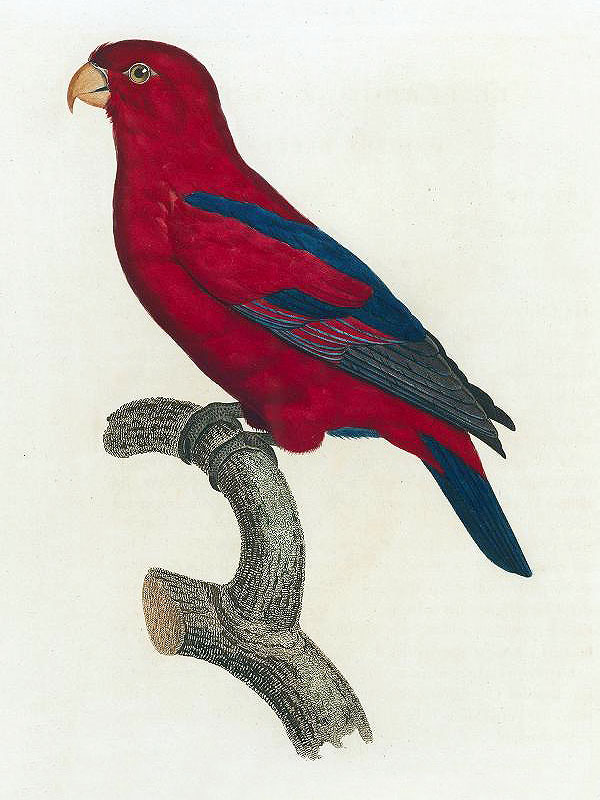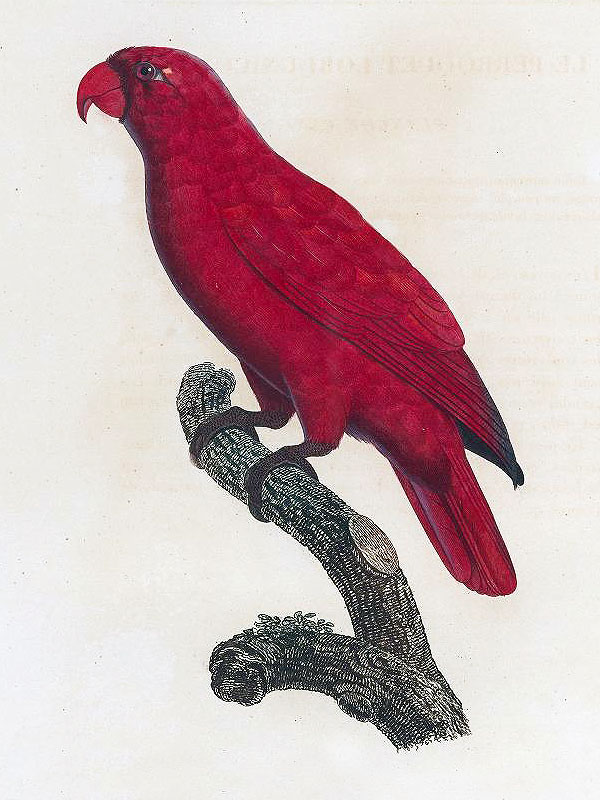Levaillant’s Blue-tailed Lory is another mysterious lory ‚described‘ at the very beginning of the 19th century by François Le Vaillant on the basis of a single specimen (alive or dead?).
The bird is very similar in many aspects to the Red Lory (Eos bornea (L.)), a species that does not occur on the island of Borneo, Indonesia, but on several small islands within the Maluku island group, Indonesia, namely Ambon, Buru, Saparua, Seram, Haruku, and the Kai Islands.
The mysterious lory differs from the Red Lory actually only in its name-giving blue tail.
The bird was never scientifically described, and since F. Le Vaillant wasn’t a fan of C. von Linné‘s binominal nomenclature system, it was only ever named as ‚Le Perroquet Lori a queue bleue‘, as ‚The Lori Parrot with a blue tail‘.
Here is the important part of Levaillant’s ‚description‘.:
„…
Le plumage général, c‘est-à-dire, celui de la tête, du cou, du dos, du croupion; les plumes des jambes du Lori à queue bleue, sont d’un rouge foncé, tirant au cramoisi. Toutes les couvertures des ailes sont du rouge cramoisi du corps, à l’exception de trois ou quatre de celles du millieu, qui sont bleu-foncé; queles autres de celles du millieu et les plus grandes sont lisérées de bleu. Les scapulaires, les deux dernières plumes des ailes près du dos, le bas-ventre et la queue entière, sont aussi bleus. Les grandes pennes alaires sont d’un noir brun. Le bec est d’un jaune d’ocre, et les pieds sont noirs.
L’espèce du Lori à queue bleue se trouve plus communément à l’île Bornéo. L’individu que nous en avons figuré de grandeur naturelle, fait partie de la belle collection de M. Raye de Breukelervaert, à Amsterdam.“
Translation:
„…
The general plumage, that is to say, that of the head, neck, back, rump; the feathers of the blue-tailed Lori’s legs are dark red, scarlet-crimson. All the wing coverts are crimson red, with the exception of three or four of the middle ones, which are dark blue; the others from the middle and the larger ones are marked with blue. The scapulars, the last two feathers of the wings near the back, the lower abdomen and the whole tail, are also blue. The large wing tips are black-brown. The beak is ochre yellow, and the feet are black.
The Blue-tailed Lori is more commonly found on Borneo Island. The individual that we have figured in natural size, is part of the beautiful collection of Mr. Raye de Breukelervaert, from Amsterdam.“ [1]
***
What or who is this Blue-tailed Lori?
Well, if F. Le Vaillant did only see a dead, a stuffed bird, this may in fact just have been a Red Lory lacking its actual tail, which had been replaced by the blue tail of any other parrot species – this method was actually quite common in these days, either to complete a incomplete specimen or even to make a complete new species, a fake species if you want, something unique that could earn high prizes other collectors in search for something unique for their collection were often willing to pay.
There existed many such collections in the 18th and early 19th century, containing real natural treasures but also things like unicorn horns, dried mermaids, and, of course fake bird species, especially birds of paradise and parrots.
It is also interesting that the island of Borneo is given as the place of origin. The bird may very well have been bought on a bird market on that island to end up as a corpse in a collection in the Netherlands, but, being definetely a member of the genus Eos, it clearly was not native to that island.
My last words here: Levaillant’s Blue-tailed Lory very likely is just a Red Lory with a fake tail.
*********************
source:
[1] François Le Vaillant: Histoire naturelle des perroquets, Paris Levrault, Schoell & Cie, An IX-XII. 1801–1805
*********************

(public domain)
*********************
edited: 02.10.2018

